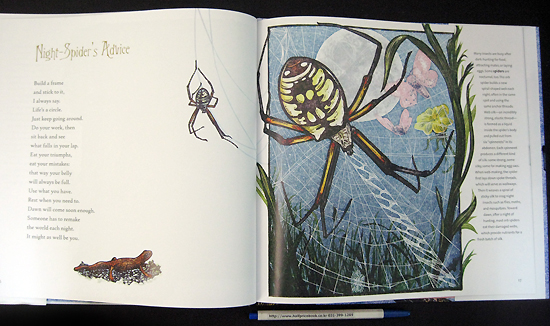|
|
|
|
 |
 이전 | 이전 |  목록 | 다음 목록 | 다음 |
|
확대 이미지 : 상세보기1

|
확대 이미지 : 상세보기2

|
확대 이미지 : 상세보기3

|
확대 이미지 : 상세보기4

|
[ 책 소개 ]
* 2011년 Newbery Honor 수상작
* NCTE Award for Excellence in Poetry for Children
* Lee Bennett Hopkins Poetry Award Honor Book
* Boston Globe/Horn Book Award Honor Book
* Cybils Poetry Award Finalist
* NCTE Notable Children's Book in the Language Arts
* Horn Book Fanfare
* Bulletin Blue Ribbon
* Booklist Editor's Choice
* CBC Bank Street Best Book of the Year (starred)
* Chicago Public Library Best book of the Year
* NSTA-CBC Outstanding Science Trade Book
* Eureka! Nonfiction Children's Book Award
미국의 저명한 여류시인인 Joyce Sidman의 대표작입니다. 수많은 동물들과 식물들이 함께 조화를 이루며 살아가는 숲 속의 다양한 모습들을 유려하면서도 절제된 문장으로 묘사한 동시 12편이 수록되어 있습니다. 화가 Rick Allen의 아름다운 목판화 그림들이 시를 더욱 돋보이게 하며, 각각의 그림 옆에는 시의 주제가 된 동물들과 식물들에 대해 설명한 글들이 함께 실려 있어서 시에 대한 이해를 도와줍니다.
큰 사이즈의 튼튼한 하드커버책입니다.
[동영상]
[ 서지 정보 ]
Hardcover: 32 pages
ISBN-10: 0547152280
ISBN-13: 978-0547152288
책 크기: 27.5 cm x 26 cm
[ 영문 서평 ]
Book Description
Come feel the cool and shadowed breeze,
come smell your way among the trees,
come touch rough bark and leathered leaves:
Welcome to the night.
Welcome to the night, where mice stir and furry moths flutter. Where snails spiral into shells as orb spiders circle in silk. Where the roots of oak trees recover and repair from their time in the light. Where the porcupette eats delicacies—raspberry leaves!—and coos and sings.
Come out to the cool, night wood, and buzz and hoot and howl—but do beware of the great horned owl—for it’s wild and it’s windy way out in the woods!
This Newbery Honor-winning picture book combines beautifully written poetry with facts of the forest and elaborate illustrations to form a marvelously engaging collection.
School Library Journal
Sidman continues her explorations of natural history in this set of poems about nocturnal life in the forest. As in her other collections, each selection is set in an expansive spread that includes a factual discussion of the featured subject. The illustrations are bold, richly detailed linoleum prints colored in gouache. The 12 poems are led by a scene setting “Welcome to the Night” and go on to feature 9 different creatures and some mushrooms with a concluding lament by the moon as night fades into morning. Sidman adroitly applies varied poetic forms and rhyme schemes. The title's dark emperor, the great horned owl, lends its shape to the one concrete poem, and the closing lament is in the medieval style known as an ubi sunt. The poetry is reflective and at times philosophical. “Build a frame/and stick to it,/I always say./Life's a circle….Eat your triumphs,/eat your mistakes:/that way your belly/will always be full…,” advises the night spider. Other poems are playful and some just a bit confusing. The porcupine poem explains that the infant of this species is known as a porcupette; the repeated use of “baby porcupette” seems oddly redundant. The bookmaking is beautiful with the concept of night lending itself generously to poetry. It invites lingering enjoyment for nature and poetry fans, and, as with Sidman's earlier collections, it might be used with varied curriculums.
Booklist *Starred Review*
Like Sidman's Caldecott Honor Book, Song of the Water Boatman and Other Pond Poems (2005), this picture book combines lyrical poetry and compelling art with science concepts. Here, poems about the woods at night reveal exciting biology facts that are explained in long notes on each double-page spread. In a poem about crickets, lines describe “the raucous scrape / of wing against wing,” while a prose passage explains that the cricket's wing has a serrated “file,” which the cricket rubs against a hard “scraper” on its other wing to attract a mate, creating a sound called “stridulation” that can swell to deafening levels. The facts are further reinforced in the accompanying picture, which shows the small file on a cricket's wing. In an opening note, Allen explains his elaborate, linoleum-block printmaking technique, and each atmospheric image shows the creatures and the dense, dark forest with astonishing clarity. Looking closely at a picture of a snail, for example, readers will see the physical detail, described in an adjacent poem, in the small animals' moist, sluglike bodies, “riding on a cushion of slime.” The thrilling title poem captures the drama of predator and prey: a mouse in the undergrowth flees an owl's “hooked face and / hungry eye.” A final glossary concludes this excellent, cross-curricular title.
|
| * 작가의 다른 작품(1) |
Red Sings from Treetops: A Year in Colors - Caldecott 메달 수상도서, 하드커버
Red Sings from Treetops: A Year in Colors
Caldecott 메달 수상도서, 하드커버 |
| * 최근 이 작품을 구입하신 분들의 다른 선택 |
A Letter to My Teacher
하드커버, 슈퍼바이 |
Titch
팻 허친스 그림책, 하드커버, 슈퍼바이 |
The Sun: Our Nearest Star
Let's-Read-and-Find-Out Science, Stage 2 |
Wreck This Picture Book
하드커버, 슈퍼바이 |
|
| |
| 평점 |
제 목 |
이름 |
조회 |
추천 |
작성일 |
|
(-1) [Exception] Invalid Data Request.
|
|
|
|